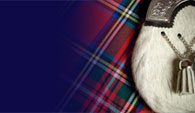Sword Dance
History: The Sword Dance or Ghillie Callum is one of the oldest of our Highland Dances. Tradition has it that Ghillie Callum refers to a Celtic Prince, Malcolm Canmore who was the victor in combat which took place in 1054. Malcolm Canmore is said to have crossed his Sword with that of his opponent symbolizing the Sign of the Cross - then danced in triumph.Interpretation: The dance portrays the agility of the Highlander dancing over the sharp cutting edges of the Sword by skilful crossing and re-crossing with intricate steps and perfect balance, the dance culminating in the dancers complete disregard for the sharp cutting edges of the double sided Broadswords as he finishes in Quick Time, his dance of defiance.
Execution: The opening step travels around the outside of the crossed swords, the remainder of the dance being performed inside, over and around the centre crossing. Each quarter step must be repeated with progression anti clockwise.
All movements in over and across the Swords must be evenly spaced. In Side and Forward Crossing and Spring Points the working leg is held straight in open positions. In turning over the Swords, the knees will be slightly flexed in Open positions.
The Dance is performed to its own traditional tune" Ghillie Callum" but is performed in two tempos, the dancer signaling for the change in tempo by clapping during the last four counts of the last slow time step.


